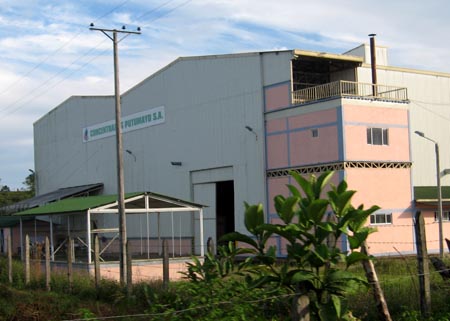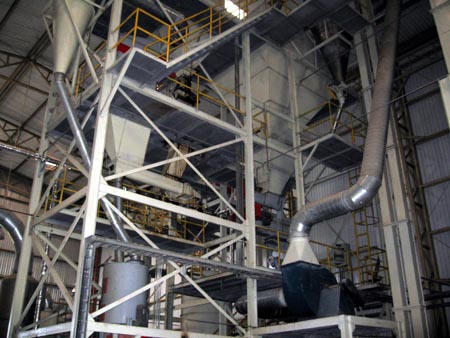« Gen. Padilla's record | Main | Three very bad weeks »
August 29, 2006
Putumayo's white elephant, or how not to win hearts and minds
While driving through the troubled department of Putumayo in southern Colombia late last month, our group decided to branch off the main road to pay a quick visit to Orito, the main town in the municipality (county) of the same name. We had heard that one of the largest projects funded by the U.S. Agency for International Development (USAID) in Putumayo, an animal-food concentrates processing plant in the town, was having some difficulties, and we hoped to be able to find out what was going on.
 |
 |
 |
The plant's concept appeared to make sense: take crops that are easily grown in Putumayo, like yuca and corn, and turn them into food for cows, pigs, chickens and other livestock. USAID and its contractors helped to set up a publicly traded company to run the plant and invested somewhere in the neighborhood of US$2 million to build the facility, buy machinery and perform studies (feasibility, environmental impact, etc.).
This high-profile project, it was hoped, would help wean thousands of Putumayo's farmers away from coca-growing, while turning a profit for its shareholders. It greatly raised expectations among a population battered by massive coca cultivation, relentless fumigation, chronic government neglect and constant violence at the hands of illegal armed groups.
We found the concentrates plant easily enough, as it was located right next to Orito's oil refinery and the base of the local Army energy-infrastructure protection battalion. It is a great-looking facility, modern and clean, with intricate machinery, a cafeteria, meeting spaces, and a big plaque thanking USAID for making the whole thing possible.
Everything looked great, except the whole scene was strangely quiet. The expensive-looking machinery was idle. There were no animal-feed concentrates, yucca or corn to be seen anywhere. The plant was not functioning.
The big building was not empty, though. About forty people were using it as a meeting space. When we arrived, several people had gathered for a job-training workshop organized by a local non-profit. Others, including two Orito council members, were assembled elsewhere in the building. When they saw us arrive, all stopped what they were doing and gethered around us - and especially me, the lone gringo in the group.
Once I explained that I wasn't from the U.S. government, but an independent investigator trying to figure out what happened, everyone started talking at once. It was like being hit by a big wave of anger and frustration. Things soon calmed down, and I tried to take notes as quickly as I could. This is more or less what the residents of Orito told me.
- The concentrates plant cost about 6 billion pesos (US$2.5 million) to establish. It opened in late 2003 and shut its doors in mid-2005. There are no plans to re-open it. The plant's machinery is already being sold off, and some had already been carted away. Residents who had been convinced to invest in the plant had lost money.
- The main reason the concentrates plant failed was a lack of inputs. Nobody wanted to sell it yuca or corn because it offered to buy it at prices considered to be ridiculously low.
The plant offered to pay 120,000 pesos - about US$50 - for a ton of yuca. That's 5 U.S. cents per kilo or 2.2 cents per pound. The same kilo of yuca could be sold in local produce markets for about eight times as much money. I was told that the cost of renting a vehicle and transporting that ton of yuca through roadless Putumayo to the processing plant would eat up more than one-third of those 120,000 pesos.
It made no sense for local farmers to sell yuca or corn to the concentrates plant, when they were guaranteed to lose money at the prices offered. The plant's managers apparently took a "take it or leave it" attitude, not budging on the price (and it is possible that they could not make money at a higher price). The farmers, of course, were happy to "leave it," selling yuca at better prices elsewhere, or braving the U.S.-funded herbicide fumigations and re-planting coca. - The plant was plagued by other problems that should have been foreseen. The machinery, most of which was apparently used and refurbished, never worked at anywhere near top efficiency. Storage of yucca and seeds was a problem in Orito's very humid climate.
- Those with whom I spoke wondered how the idea of a concentrates plant was chosen, alleging that the community was never asked. Others wondered why it was located in oil-producing Orito, when better soils for growing yuca and corn were located in municipalities about an hour's drive to the south.
Since 2000, U.S.-funded planes have sprayed herbicides over 155,534 hectares (about 390,000 acres) of Putumayo, making it the second most-fumigated of Colombia's thirty-two departments during this period. The "stick" of fumigation has been strong and swift, but the "carrot" of development aid has not only been smaller - only 20 percent of U.S. aid to Colombia is non-military - but it has been slower to arrive, haphazardly planned, and has largely failed to improve lives and livelihoods. "Orito today is in its worst economic crisis," a councilmember told me.
After about half an hour, we left the plant and got back on the road. I lamely promised those assembled at the plant that I would at least inform my fellow citizens and my lawmakers about what I saw there.
My nauseating experience in Orito was made possible by one of the most frustrating things about watching U.S. policy unfold in Colombia over the past several years: its systematic undervaluing and neglect of all things non-military.
For planners of U.S. assistance to Colombia, non-military programs have always been an afterthought. Four out of five dollars in U.S. aid goes to Colombia's armed forces, police, and fumigation program. Policymakers have placed a far lower priority on the rest of the aid, which is intended to support governance and development.
Too often, these funds go to programs that are improvised, uncoordinated, left entirely up to contractors, carry high overhead costs, and appear to ignore completely the lessons of similar efforts taken elsewhere. Oversight is weak, dubious claims of success go unquestioned, higher-level officials show little interest. It's easy to get the impression that nobody in charge of these projects cares whether they succeed or not: the point is to spend the money and demonstrate that an objective was fulfilled. The Orito concentrates plant is a perfect example.
The U.S. and Colombian governments have claimed to be pursuing many goals in Colombia, from fighting drugs to fighting guerrillas to simply making Colombia a more just, lawful, prosperous society. To achieve any of these goals, a strategy will fail if it lacks a major investment in governance and development - especially in the vast, stateless rural areas where armed groups and drug crops thrive. Spray planes and military sweeps cannot do it on their own.
But look no further than Putumayo to see the tragedy of alternative development in Colombia. Plan Colombia began in 2000 with Putumayo in mind: at the time, this province of 350,000 people had more coca than any other in the country, and was overrun by guerrillas and paramilitaries. A U.S.-funded "push to the south" would insert new military units in Putumayo and initiate a massive campaign of aerial herbicide fumigation. Next would come aid to help the region's coca farmers to switch to legal crops.
Yet five years later, the United Nations found that Putumayo was still the country's number-three coca-growing department. Today, it is still overrun by armed groups, and it is safe to say that Putumayo's population has not experienced a flowering of affection for its government institutions.
It is not news that progress will be only temporary until Colombians who live in depressed rural areas like Orito - a minority of the population living in the majority of the country's territory - can trust their government to protect them, to enforce laws and to make a functioning legal economy possible. Counter-insurgency experts have said for decades that "the people are the center of gravity."
But in Orito, Putumayo - right in the middle of one of the main battlegrounds for the Colombian government's U.S.-aided counter-insurgency effort - the people I talked to are very, very angry. The angrier and more distrustful they get, the more likely it is that even the small security gains that the Uribe government has achieved will be reversed.
Posted by isacson at August 29, 2006 12:44 PM
Comments
Thanks for update on Putumayo, Mr. Isacson. Yup, this is a white elephant indeed. A huge, smelly, but ultimately still tragic white elephant.
It makes no sense to create such projects with the goal of "winning hearts and minds" if no sustained effort is going to be made, by *both* the U.S. and Colombian governments, to actually give this sort programs the attention, oversight and resources they need to be of any use.
I'd also like to point to a different but clearly related and often overlooked matter: It is also of little use for the U.S. to restrict its trade negotiations with Colombia to the "purely economic" sphere, when the fallout of white elephants such as this one in Putumayo needs immediate attention, even at the cost of the "optimal" profit margin of U.S. companies and interest groups.
Why can't the U.S. government support USAID by making an exception and, say, proactively allow impoverished farmers in Putumayo to make a reasonable living out of legal crops, by properly funding these alternative projects and by giving Colombia certain exceptional trade preferences directly related to the *specific* products involved in them? That way, former coca farmers will really want to grow and sell yuca and will be less likely to go back to illicit crops, because they'll see a clear benefit due to the increased attention, funding and access to U.S. markets: the abandoned factory would actually be able to offer good prices.
You can't possibly expect to "deal with Colombia as a whole" and win this thing, ignoring that special circumstances (a country with a sizable number of coca farmers who need real alternatives) require better treatment than what economic orthodoxy demands. Unfortunately, this was pretty much overlooked during U.S.-Colombia trade talks, despite some timid attempts to raise the issue on Colombia's part.
Instead it seems that, for the U.S. government, having an "economic sense" is equal to insulating "the economy" from the requirements of a better antidrug policy, yet still blindly throwing countless resources at a bottomless counternarcotics effort dominated by the stick, overlooking the existence of the white elephants that are eating the carrots. If U.S. and Colombian trade negotiations had actually taken this into consideration, perhaps there would have been an easier way out of all this mess.
Posted by: jcg ![[TypeKey Profile Page]](http://www.ciponline.org/colombia/blog/nav-commenters.gif) at August 29, 2006 9:04 PM
at August 29, 2006 9:04 PM
Thanks for the example of the processing plant, Adam. Unfortunately, it appears to be very typical. One can only sigh.
Posted by: richtiger ![[TypeKey Profile Page]](http://www.ciponline.org/colombia/blog/nav-commenters.gif) at August 31, 2006 1:12 AM
at August 31, 2006 1:12 AM
Post a comment
Thanks for signing in, . Now you can comment. (sign out)
(If you haven't left a comment here before, you may need to be approved by the site owner before your comment will appear. Until then, it won't appear on the entry. Thanks for waiting.)